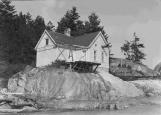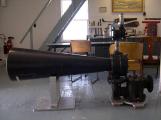27
The first fog alarm was called a Scotch Siren and was powered by a coal-generated steam plant. The coal was landed annually by boat and hauled by derrick to the engine room. If the coal supply was exhausted, wood was gathered from the beach and cut from the surrounding area.28
The arrival of the fog alarm meant a dramatic increase in the volume of the keeper's duties. The light keeper continually watched for fog and put the horn into operation if visibility fell below three miles. It took approximately forty minutes from the time the fire was first lit to generate enough steam to run the horn. When the plant was running, the keeper had to constantly feed the engines with coal to maintain an adequate level of steam. The first fog horn building was located on the west side of the tower. A reservoir was built behind it to provide a constant supply of water to the boilers.29
Light keepers meticulously recorded the amount of fuel used by the fog alarm.1937
Point Atkinson, West Vancouver, British Columbia, Canada

30
Fog horn building.1930
Point Atkinson, West Vancouver, British Columbia, Canada
 Credits:
Credits:Courtesy of the Vancouver Maritime Museum.
31
When the present tower was built in 1912, the fog horn building was relocated right in front of the tower and the Scotch Siren was replaced by a powerful diaphone horn. The new horn acquired the nickname, "Old Wahoo." The six horsepower Fairbanks Morris engine that ran the new horn was housed in a separate building behind the tower. The deep sound of the diaphone comes from a cylindrical piston that lies inside an air chamber and moves with the force of compressed air. The first big sound was produced when the piston moved forward and the lower note was the result of the piston slowing down. The horn gave one blast of 2 ˝ seconds, every 57 ˝ seconds.32
The foghorn changed the keeper's responsibilities drastically: it shifted responsibility for sounding the alarm from the ship's captain to the keeper. According to Don Graham: "The arrival of a fog horn on a station entailed a revolutionary transformation of the keeper's responsibilities. Before the sounding of the horn was the prerogative of ship's captains. Steaming toward the harbour through fog, the captain gave the order to sound three rapid blasts of his ship's horn. When they heard this signal, Erwin and his fellow keepers would carry a hand-horn outside. This horn was a system of twin bellows, worked by wrenching a handle back and forth. Lightkeepers would pump away at prescribed intervals until signalled by the vessel to stop."Once the steam plant was built, however, ship's masters no longer initiated the signal. It was up to the keeper to shovel coal and raise steam whenever fog or smoke advanced to within four miles during squalls, heavy rain, or snowstorms. 'At all times, night and day…a careful watch on the weather is to be maintained,' Erwin was instructed, 'and on no account whatever is this regulation to be broken, even during prevailing clear weather.' The horn, sitting in its lair down below, was a mechanical tyrant." (Keepers, 67)
33
Engine and compressor for fog alarm.1930
Point Atkinson, West Vancouver, British Columbia, Canada
 Credits:
Credits:Courtesy of Dave Grafton.
34
As Don Graham recounts in his history of British Columbia keepers, the new foghorn added more cleaning duties to the roster of keeper's responsibilities:"Once a month he had to open the boiler, crawl into its damp innards, hammer off any deposits on the walls, and hose it out. When the plant was in operation he was compelled to stay inside, in that ear-splitting din of hissing steam and flapping belts, with the bellowing horn rattling tools on their racks. Erwin could be relieved 'for meals &c' only by another competent hand. When thick weather finally cleared (in 1896 he logged 1450 hours of it), he had to shut the plant down, rub down all the machinery, sweep up coal dust, dump clinkers out of the grates, then polish lubricators, flywheel rims, and all the other brass work before locking the doors and trudging up to the house to watch for more fog. In clear weather he packed sacks of coal and hauled water for the boiler. In February 1897 Erwin exhausted his annual coal supply and began cutting trees for fuel. All too often it was an exercise in frustration when the fog stopped by long enough to exhaust his entire supply of split kindling, then capriciously moved on."
35
Derrick for delivering coal to power the fog alarm.1936
Point Atkinson, West Vancouver, British Columbia, Canada
 Credits:
Credits:Courtesy of Norm Dawe.
36
Laurence Grafton remembers using the fog horn:The industrial area on False Creek was a curse because the smog would drift out at across English Bay. The midnight boat to Victoria would come out…. When you lost sight of English bay, you were on the watch and the horn had to be on. You had no way of telling how severe it was, whether it was fog, or whether it was smog or what it was…. You had to start the engines and get the compressors going. Invariably, you had your compressed air in the big tank. Dad used to go up when the ships would start blowing their whistles. He would go up and give it a manual blast before we got the engines going. The tank was probably about twelve feet high and eight feet around…. I remember one summer with fire, smoke, forest fires. We had nine days and nights operating the foghorn. And those old engines, I'll tell you, they were pretty tough.
37
Fog horn at Point Atkinson Lighthouse.2004
Point Atkinson, West Vancouver, British Columbia, Canada

39
Norm Dawe remembers:When it was foggy, visibility under three miles, then the horn would have to be put in operation…well you had to start the engines up, depending whether you were using one of them or two of them. The original Fairbanks were six horse Fairbanks, single cylinder jobs. They were connected with belt drives to compressors, which compressed the air in a big tank. This tank would have been maybe ten to twelve feet high, diameter [would be] six to seven feet. You build up your air pressure, around thirty pounds and then you start the timer on the horn and that was just belt-driven mechanical type of thing, when the wheel went around it had a little lump on it and when the little lump hit the valve it would open and let the air through and continue on. Your engines had to be tended. They were not sophisticated engines. They had drip-type lubricant.
40
Front of manual fog horn at Point Atkinson Lighthouse.2004
Point Atkinson, West Vancouver, British Columbia, Canada

